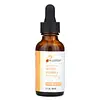What's inside
What's inside
 Key Ingredients
Key Ingredients

 Benefits
Benefits

 Concerns
Concerns

 Ingredients Side-by-side
Ingredients Side-by-side

Water
Skin ConditioningHydrolyzed Jojoba Esters
Skin ConditioningGlycerin
HumectantHordeum Vulgare Seed Extract
Skin ConditioningRetinol
Skin ConditioningSodium Hyaluronate
HumectantSodium Ascorbate
AntioxidantAvena Sativa Kernel Extract
AbrasivePrunus Persica Leaf Extract
EmollientCucurbita Pepo Seed Extract
Skin ConditioningCaprylic/Capric Triglyceride
MaskingTocopherol
AntioxidantCitric Acid
BufferingXanthan Gum
EmulsifyingAcacia Senegal Gum
MaskingSodium Phytate
Alcohol
AntimicrobialPhenoxyethanol
PreservativeEthylhexylglycerin
Skin ConditioningWater, Hydrolyzed Jojoba Esters, Glycerin, Hordeum Vulgare Seed Extract, Retinol, Sodium Hyaluronate, Sodium Ascorbate, Avena Sativa Kernel Extract, Prunus Persica Leaf Extract, Cucurbita Pepo Seed Extract, Caprylic/Capric Triglyceride, Tocopherol, Citric Acid, Xanthan Gum, Acacia Senegal Gum, Sodium Phytate, Alcohol, Phenoxyethanol, Ethylhexylglycerin
Water
Skin ConditioningGlycerin
HumectantAcacia Seyal Gum Extract
HumectantRetinol
Skin ConditioningMethyl Methacrylate/Glycol Dimethacrylate Crosspolymer
Acetyl Heptapeptide-4
HumectantNiacinamide
SmoothingRosmarinus Officinalis Extract
AntimicrobialCitrus Nobilis Peel Extract
MaskingAscorbic Acid
AntioxidantTocopheryl Acetate
AntioxidantCitric Acid
BufferingCarbomer
Emulsion StabilisingPotassium Sorbate
PreservativeHydroxyethylcellulose
Emulsion StabilisingCaprylyl Glycol
EmollientDisodium EDTA
Propyl Gallate
AntioxidantBHT
AntioxidantWater, Glycerin, Acacia Seyal Gum Extract, Retinol, Methyl Methacrylate/Glycol Dimethacrylate Crosspolymer, Acetyl Heptapeptide-4, Niacinamide, Rosmarinus Officinalis Extract, Citrus Nobilis Peel Extract, Ascorbic Acid, Tocopheryl Acetate, Citric Acid, Carbomer, Potassium Sorbate, Hydroxyethylcellulose, Caprylyl Glycol, Disodium EDTA, Propyl Gallate, BHT
Ingredients Explained
These ingredients are found in both products.
Ingredients higher up in an ingredient list are typically present in a larger amount.
Citric Acid is an alpha hydroxy acid (AHA) naturally found in citrus fruits like oranges, lemons, and limes.
Like other AHAs, citric acid can exfoliate skin by breaking down the bonds that hold dead skin cells together. This helps reveal smoother and brighter skin underneath.
However, this exfoliating effect only happens at high concentrations (20%) which can be hard to find in cosmetic products.
Due to this, citric acid is usually included in small amounts as a pH adjuster. This helps keep products slightly more acidic and compatible with skin's natural pH.
In skincare formulas, citric acid can:
While it can provide some skin benefits, research shows lactic acid and glycolic acid are generally more effective and less irritating exfoliants.
Most citric acid used in skincare today is made by fermenting sugars (usually from molasses). This synthetic version is identical to the natural citrus form but easier to stabilize and use in formulations.
Read more about some other popular AHA's here:
Learn more about Citric AcidGlycerin is already naturally found in your skin. It helps moisturize and protect your skin.
A study from 2016 found glycerin to be more effective as a humectant than AHAs and hyaluronic acid.
As a humectant, it helps the skin stay hydrated by pulling moisture to your skin. The low molecular weight of glycerin allows it to pull moisture into the deeper layers of your skin.
Hydrated skin improves your skin barrier; Your skin barrier helps protect against irritants and bacteria.
Glycerin has also been found to have antimicrobial and antiviral properties. Due to these properties, glycerin is often used in wound and burn treatments.
In cosmetics, glycerin is usually derived from plants such as soybean or palm. However, it can also be sourced from animals, such as tallow or animal fat.
This ingredient is organic, colorless, odorless, and non-toxic.
Glycerin is the name for this ingredient in American English. British English uses Glycerol/Glycerine.
Learn more about GlycerinRetinol is a gold-standard ingredient for anti-aging. It is a form of Vitamin A and belongs to the class of retinoids that also includes tretinoin.
Why is retinol famous?
It has the most scientific studies backing up its skin benefits out of all the non-prescription ingredients.
Retinol is proven to:
This is why retinol is effective at removing wrinkles, fading dark spots, treating acne, and reducing the appearance of pores.
Studies show retinol is less effective when exposed to UV. Be sure to look for appropriate packaging to keep your retinol potent (similar to Vitamin C).
Using retinol or any retinoids will increase sun-sensitivity in the first few months. Though studies show retinoids increase your skin's natural SPF with continuous use, it is best to always wear sunscreen and sun-protection.
We recommend speaking with a medical professional about using this ingredient during pregnancy.
Retinol may cause irritation in some people, so be sure to patch test. Experts recommend 'ramping up' retinol use: start using this ingredient once a week and work up to using it daily.
Read about Tretinoin
Learn more about RetinolWater. It's the most common cosmetic ingredient of all. You'll usually see it at the top of ingredient lists, meaning that it makes up the largest part of the product.
So why is it so popular? Water most often acts as a solvent - this means that it helps dissolve other ingredients into the formulation.
You'll also recognize water as that liquid we all need to stay alive. If you see this, drink a glass of water. Stay hydrated!
Learn more about Water